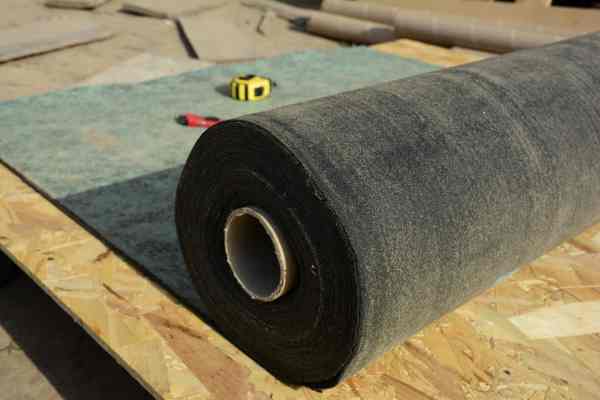Table of Contents:
Key Takeaway: Roofing felt is not inherently toxic, but certain aspects of its composition can lead to potential health risks if not handled appropriately. It is crucial to understand the types of roofing felt materials and their associated risks to ensure safety during installation or any other roofing-related activities.
Introduction
Roofing felt, also known as tar paper or underlayment, is a commonly used material in roofing projects. It plays a vital role in protecting the underlying roof structure from water infiltration and acts as a barrier against external elements. However, concerns may arise regarding the potential toxicity of roofing felt materials and their impact on human health.
What is Roofing Felt?
Roofing felt is a durable, water-resistant material typically made of a combination of organic fibers (such as paper or cellulose) and asphalt. Its flexible nature allows it to conform to the roof’s surface, providing an added layer of protection before the final roofing materials, such as shingles, are installed.
Types of Roofing Felt Materials
1. Organic Roofing Felt: Traditional roofing felts were primarily made from organic materials like paper fibers. While they were commonly used in the past, modern construction practices have shifted towards synthetic materials due to concerns about potential risks associated with organics.
2. Synthetic Roofing Felt: Synthetic or non-organic roofing felts have gained popularity in recent years. These materials are usually composed of fiberglass or polyester, providing enhanced durability and increased resistance to water penetration.
Understanding Toxicity in Roofing Felt
Roofing felt itself does not inherently contain toxic substances. However, certain factors can contribute to potential toxicity:
1. Asphalt Content: Most roofing felts have an asphalt composition. While asphalt is not extremely toxic, prolonged exposure to its fumes can cause irritation to the respiratory system, eyes, and skin. It is important to take precautions when working with roofing felt to minimize exposure to these fumes.
2. Chemical Additives: Some roofing felts may contain chemical additives, such as fire retardants or pesticides. These additives have the potential to release harmful fumes when exposed to high temperatures or intense heat. It is essential to check the product specifications and consult with manufacturers or professionals to understand the composition of the roofing felt being used.
Health Implications and Risks
Exposure to roofing felt and its potential risks may vary depending on the specific materials used, the duration of exposure, and the Work Environment. The following are some health implications associated with improper handling or excessive exposure to roofing felt:
1. Respiratory Issues: Inhaling fumes emitted by asphalt-based roofing felts can irritate the respiratory system, potentially leading to respiratory problems such as coughing, wheezing, or shortness of breath. Individuals with pre-existing respiratory conditions may be more susceptible to these effects.
2. Skin Irritation: Contact with asphalt or certain chemicals found in roofing felts can cause skin irritation, leading to redness, itching, or allergic reactions. Direct and prolonged skin contact should be avoided, and appropriate protective gear, such as gloves, should be worn during any roofing-related activities.
3. Eye Irritation: Roofing felts, if handled improperly, can release particles or fumes that can irritate the eyes. Eye protection, such as safety goggles, should be worn to prevent irritation or potential damage to the eyes.
Safety Precautions
To ensure safety when working with roofing felts, consider the following precautions:
1. Ventilation: Adequate ventilation is important when handling roofing felts. Ensure that the work area is well-ventilated to minimize exposure to any potential fumes or particles.
2. Personal Protective Equipment (PPE): Wear appropriate PPE, such as gloves, safety goggles, and protective clothing, to minimize direct contact with roofing felts and reduce the risk of skin or eye irritation.
3. Work Environment: Avoid working in extremely hot or humid conditions, as this can intensify the release of fumes from roofing felts. Consider scheduling roofing projects during cooler periods or plan for work during early morning or late afternoon when temperatures may be lower.
Conclusion
Roofing felt, when handled properly and with appropriate safety precautions, does not pose significant toxicity risks to individuals involved in roofing projects. Understanding the composition of different roofing felt materials and the potential risks associated with improper handling is crucial for ensuring safety and minimizing any adverse health effects.
Frequently Asked Questions
Q: Can the asphalt fumes from roofing felts cause long-term health problems?
A: Prolonged exposure to asphalt fumes can potentially lead to long-term health issues. It is advisable to take necessary precautions, such as using proper ventilation and personal protective equipment, to minimize exposure.
Q: Are synthetic roofing felts safer than organic materials?
A: Synthetic roofing felts are generally considered safer due to their reduced susceptibility to mold, decay, and fire hazards. They also tend to emit fewer fumes compared to organic felts; however, it is important to handle all materials with care and follow proper safety guidelines.
Q: Should I consult professionals before using roofing felts?
A: It is always recommended to consult with professionals or manufacturers to ensure you select the right type of roofing felt for your project. They can provide guidance on handling, installation, and any specific safety precautions that may be required.
Q: Do all roofing felts contain chemical additives?
A: Not all roofing felts contain chemical additives. However, some specialized products, such as those designed for fire resistance or pest control, may incorporate specific additives. It is important to verify the composition of the roofing felt being used and take appropriate precautions accordingly.
nnn.ng
https://nnn.ng/faq/26282/














